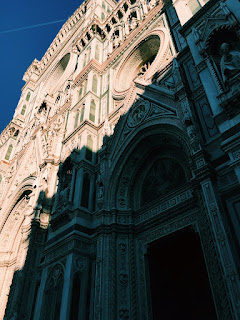The walk to the park was a little confusing, what with the slightly harrowing traffic signals and a couple of narrow tunnels under the rail road tracks, but when I arrived, I knew it was worth it. After passing through the wrought-iron front gates, you climb a set of cracked stone steps up to the Villa Fabbricotti, a small but impressive-looking building who's purpose I'm not sure of. From the top of the hill you get a nice little view of the city in between the trees. The narrow streets and rumble of traffic feels miles away.
I spent a good hour and a half exploring the park, which is divided into two sections. The most impressive section was the grounds of the Museo Stibbert, which was full of mysterious ivy-covered walls, pathways guarded by statues, and even an imitation egyptian temple on the bank of a pond. Maybe it's because I'm listening to it on audiobook, but I couldn't help feeling like Mary Lennox discovering the secret garden. There's definitely something to be said for wandering for its own sake, especially when you're traipsing along muddy paths and pretending to be straight out of the pages of an edwardian children's book.
On Monday we visited the Palazzo Vecchio. The amazing thing about so many monuments in ancient cities like Florence, is that a lot of them are built on the sites of old roman structures. The Palazzo Vecchio was built on top of the Roman theatre. Amazingly, you can walk around below the Palazzo and see the ruins of the theatre. There were places where medieval stone work gave way to the ruins of ancient structures. Jodie, the director of the program, always talks about "reading buildings" in order to understand their history, and looking at the layers of stone underneath the Palazzo Vecchio felt a bit like seeing time itself layered in physical space. The Palazzo itself was absolutely stunning. Jodie told us how it had oscillated between being a public building to being the palace of the Medici family, and it was interesting to see how the decorative frescoes or intricate ceiling murals reflected the passing between families and generations, and how their meanings changed with each new inhabitant. We stood in the grand hall where frescoes by DaVinci and Michelangelo had once been displayed side by side (though neither were ever completely finished), and stood in the atrium for ten minutes "reading" the multiple architectural styles that had been added on over the centuries. One of the most amazing things about the Palazzo Vecchio is that even though the majority of it is a museum, it's still Florence's city hall building, and the back rooms house the mayor's and city council offices.
So far I've been learning and experiencing so much that it's hard to distill into words. I'm not sure what memories will be more important to me: the things I learned about history and culture, or the little moments and inside jokes I shared with friends between classes. As of right now, I'm just trying to document everything as best I can: keeping a journal, writing things people say in my notebook, and publishing on this blog. I've also been feeling the itch I get when I haven't written creatively in a while. Stay tuned for a post next week about staying creative while abroad. (Hint: it's not easy, but it's doable).
Until next time, ciao!
 |
| Incredible early-morning view from my Italian classroom |









No comments:
Post a Comment